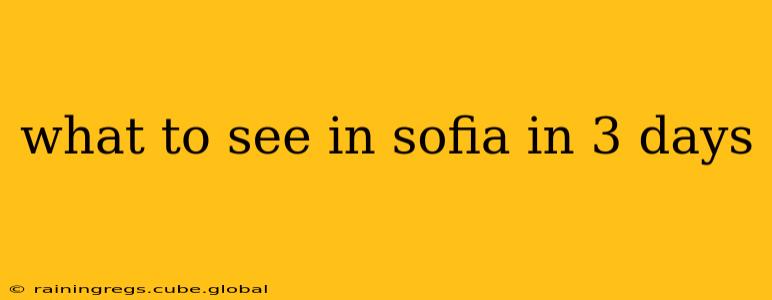What to See in Sofia in 3 Days: A Comprehensive Guide
Sofia, Bulgaria's vibrant capital, offers a captivating blend of history, culture, and modern life. Three days is enough time to explore its significant landmarks and experience its unique charm. This itinerary balances iconic sights with hidden gems, ensuring a memorable trip.
Day 1: Exploring Historical Sofia
Start your Sofia adventure at Alexander Nevsky Cathedral, a breathtaking masterpiece of Bulgarian architecture. Its opulent interior and imposing exterior are truly awe-inspiring. Allow ample time to admire its grandeur.
Next, wander through Serdica, the ancient Roman ruins nestled beneath modern Sofia. These well-preserved remains offer a fascinating glimpse into the city's rich past. You can easily spend an hour or more here, imagining life in Roman times.
Afterward, head to the National Archaeological Museum, home to an extensive collection of artifacts spanning millennia of Bulgarian history. It's a must-visit for history buffs.
In the afternoon, take a stroll through Borisova Gradina, Sofia's largest park. It's a perfect place to relax, enjoy the greenery, and perhaps grab a coffee or snack at one of the park's cafes.
For the evening, explore the charming streets of the old town, discovering hidden courtyards and traditional restaurants. Consider trying some local Bulgarian cuisine – you won't be disappointed!
What are the must-see attractions in Sofia?
This is a frequently asked question, and the answer depends on your interests. However, Alexander Nevsky Cathedral, Serdica, the National Archaeological Museum, and the Russian Church are all considered must-see attractions for their historical significance and architectural beauty. Don't forget to include a walk through the beautiful Borisova Gradina park in your itinerary as well.
Day 2: Culture, Art, and Panoramic Views
Begin your second day at the National Gallery for Foreign Art, showcasing a diverse collection of European and world art. Afterward, explore the National Historical Museum, offering a comprehensive overview of Bulgarian history and culture.
For lunch, explore the vibrant Central Market Hall, a bustling marketplace offering a wide array of local produce, meats, and cheeses. It's a great place to experience authentic Bulgarian life.
In the afternoon, ascend Vitosha Mountain for breathtaking panoramic views of Sofia. You can take a cable car or hike up depending on your preference and fitness level. The views from the top are simply stunning.
In the evening, enjoy a traditional Bulgarian folk performance – a great way to experience the country’s rich cultural heritage.
How much time should I spend in each place?
The time spent at each location depends on your interests. Allow at least 2 hours for Alexander Nevsky Cathedral and the National Archaeological Museum. Serdica can take an hour, and the National Gallery requires at least 1.5 - 2 hours depending on your interest in art. Allocate time based on your preferences, allowing flexibility for spontaneous discoveries.
Day 3: Day Trips and Hidden Gems
Consider a day trip to Rila Monastery, a UNESCO World Heritage site showcasing stunning architecture and religious significance. It's a bit outside of Sofia, but the journey is well worth it. (This requires an early start).
Alternatively, if you prefer to stay closer to Sofia, explore the Church of St. Sofia, a historical landmark that gives the city its name. Explore some of the smaller, less-visited churches and museums for a more intimate experience.
Spend your afternoon exploring the National Palace of Culture, a large multifunctional complex hosting various events and exhibitions. Check their schedule to see if anything interesting is happening during your visit.
Enjoy a final evening in Sofia, perhaps indulging in a farewell dinner at a restaurant overlooking the city.
Are there any free activities in Sofia?
Yes! Walking through Borisova Gradina, exploring the streets of the old town, and visiting some of the exterior areas of historical sites are all free. Many churches also allow free entry, although donations are usually appreciated.
What is the best way to get around Sofia?
Sofia has a good public transportation system, including buses and trams, which is a cost-effective way to get around. Taxis and ride-sharing services are also readily available. Walking is a great way to explore the city center.
This itinerary provides a framework; feel free to adapt it based on your interests and pace. Remember to wear comfortable shoes, as you'll be doing a fair bit of walking. Enjoy your unforgettable trip to Sofia!
